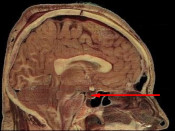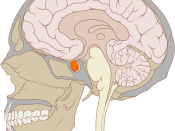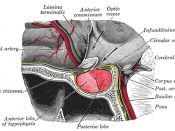The Pituitary Gland is situated at the base of the brain and it produces hormones which control growth. Too large an amount of these hormones causes giantism, a condition where facial features, hands, etc. become abnormally large. Too little causes dwarfism, where the overall stature of a person is very small.
Dwarfism is the condition of being undersized, or less than 127 cm (50 in) in height. Some dwarfs have been less than 64 cm (24 in) in height when fully grown. The word midget is usually applied to dwarfs. Another growth disorder disease is Cretinism which is a result of a disease of the thyroid gland it is the cause of most dwarfism in Europe, Canada, and the United States. Other causes of dwarfism are Down's syndrome, a congenital condition with symptoms similar to those of cretinism, achondroplasia, a disease characterized by short extremities resulting from absorption of cartilaginous tissue during the fetal stage, spinal tuberculosis, and deficiency of the secretions of the pituitary gland or of the ovary.
Causes of pituitary dwarfism may vary. Abnormally short height in childhood may be due to the pituitary gland not functioning correctly, resulting in underproduction of growth hormone. This may result from a tumor in the pituitary gland, absence of the pituitary gland, or trauma.
Growth retardation may become evident in infancy and persists throughout childhood. Normal puberty may or may not occur depending on the degree of pituitary insufficiency that is present, which is the inability of the pituitary to produce adequate hormone levels other than growth hormone.
Physical defects of the face and skull may also be associated with abnormalities of the pituitary gland. A small percentage of infants with cleft lip and cleft palate may have decreased growth hormone levels.
No ideal treatment has been developed yet for...


